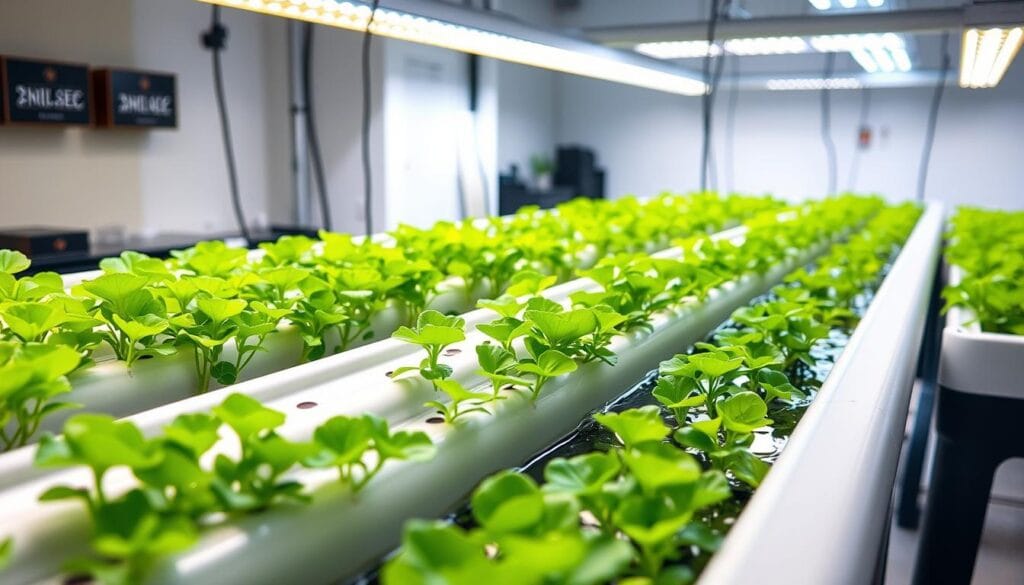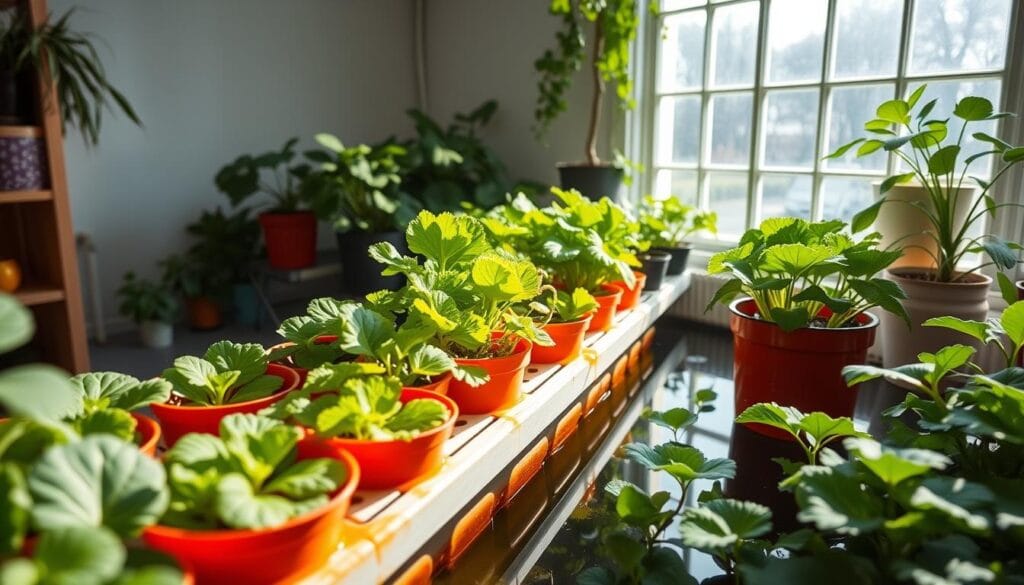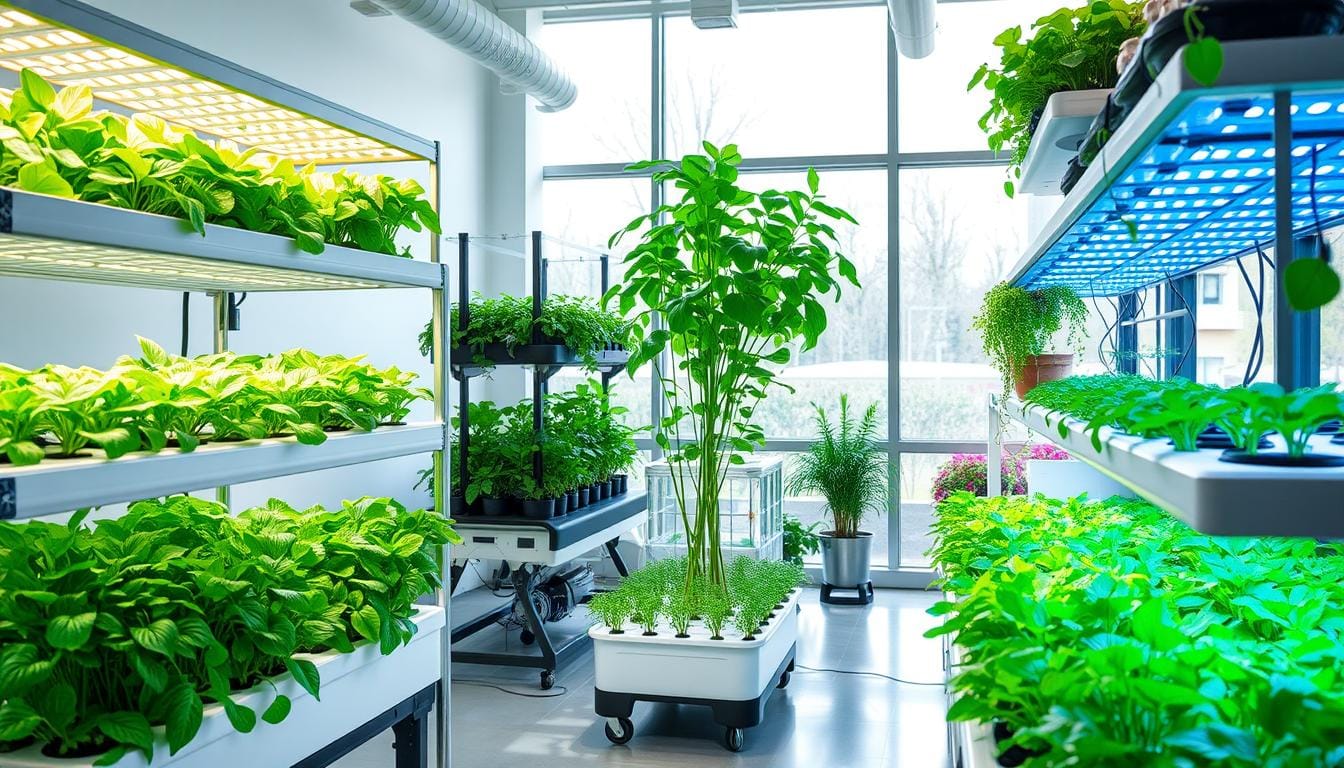I’ve always been captivated by the wonder of nature. I wanted to grow my own plants indoors. But regular gardening was too much work. That’s when I found hydroponics – a modern way to grow plants without soil.
Now, I see many options like the AeroGarden, Click & Grow, and Gardyn. These systems can grow up to 30 different plants. They’re all about making gardening easy and efficient. However, I’m still uncertain about which one suits me best.
Key Takeaways
- Hydroponic systems offer efficient and automated indoor gardening solutions, with popular options like AeroGarden, Click & Grow, and Gardyn.
- These systems vary in plant capacity, from 12 to 30 plants, and cater to different gardening needs and budgets.
- Factors like initial investment, maintenance requirements, and system capabilities should be considered when choosing the best hydroponic system.
- Hydroponic cultivation can provide a sustainable and space-saving alternative to traditional soil-based gardening.
- Researching the unique features and benefits of each hydroponic system is crucial to finding the right fit for your indoor gardening goals.
Understanding Hydroponic Growing Systems Basics
Hydroponic gardening offers a method to grow plants without the need for soil. Instead, plants are grown in water that’s full of nutrients. This method is becoming more popular because it has many benefits over traditional gardening.
What Makes Hydroponic Systems Different from Traditional Gardening
Hydroponic gardening is different because it gives plants nutrients directly. The roots soak in a solution that has everything plants need. This is different from traditional gardening, where plants get nutrients slowly from the soil.
Key Components of Hydroponic Systems
Hydroponic systems have a few important parts. There’s a water reservoir, grow lights, and a way to get nutrients to the roots. The reservoir holds the nutrient solution. Grow lights help plants grow by providing light when there isn’t enough natural light. The nutrient delivery system makes sure plants get all the nutrients they need.
Benefits of Soilless Growing Methods
Hydroponic gardening has many benefits. Plants grow faster and produce more. It’s also possible to grow plants all year, no matter the weather outside. Using hydroponic systems can reduce water usage by up to 90% versus conventional farming.
They also let gardeners control things like temperature and nutrient levels. This helps plants grow better and stay healthy.
| Hydroponic Gardening | Traditional Gardening |
|---|---|
| Uses 90% less water than traditional agriculture | Relies on soil-based nutrient delivery |
| Allows for precise control over environmental factors | Dependent on natural outdoor conditions |
| Facilitates faster plant growth and higher yields | Slower growth and potentially lower yields |
| Can be grown year-round in a controlled environment | Limited to specific growing seasons |
Learning about hydroponic systems can help gardeners decide if it’s right for them. It’s a new and sustainable way to grow plants.
Best Hydroponic Systems Comparison
Hydroponic systems are great for indoor gardening because they control the growing environment. They are perfect for growing many types of plants. Let’s look at some top hydroponic systems for your indoor garden.
The AeroGarden Bounty can grow up to 9 plants and is 24 inches tall. It has a touch screen and features like vacation mode and smart grow lights. The Moistenland Indoor Garden Starter Kit is cheaper. It can grow 12 plants and has a grow light timer.
The Lettuce Grow Farmstand is great for big projects. It can grow 36 plants and has a 20-gallon water reservoir. The AeroGarden Harvest is easy to start with. It features user-friendly controls and is straightforward to set up.
The Gardyn Home Kit 2.0 has cool features like touch screens and vacation modes. These systems were tested for 6 weeks or more. They were checked for performance, ease of use, and value.
| Hydroponic System | Plant Capacity | Grow Height | Key Features |
|---|---|---|---|
| AeroGarden Bounty | 9 plants | 24 inches | Touch screen, vacation mode, smart grow lights |
| Moistenland Indoor Garden Starter Kit | 12 plants | N/A | Budget-friendly, 18-hours-on/6-hours-off grow light timer |
| Lettuce Grow Farmstand | 36 plants | N/A | Large capacity, 20-gallon water reservoir |
| AeroGarden Harvest | 6 plants | 12 inches | Beginner-friendly, simple setup and controls |
| Gardyn Home Kit 2.0 | 30 plants | N/A | Touch screen, vacation mode, smart automation |
When picking a hydroponic system, think about plant capacity, grow height, and ease of use. The systems mentioned offer many options for different needs and budgets. This makes it easier to find the right one for your indoor garden.
Deep Water Culture (DWC) Systems: Key Features and Advantages
Deep Water Culture (DWC) systems are a favorite in hydroponic gardening. They grow plants without soil by suspending roots in a nutrient-rich water solution. This setup provides all the necessary elements for healthy plant growth.
How DWC Systems Work
DWC systems use air pumps and air stones to keep the water aerated. This ensures the roots get enough oxygen. Plants are supported by net pots or containers, allowing roots to reach the water while stems and leaves grow above.
Advantages and Limitations of DWC
- DWC systems are simple, low maintenance, and quick to establish a thriving garden.
- However, they use a lot of water and can overheat, stressing plants.
Ideal Plants for DWC Growing
DWC systems are great for leafy greens, herbs, and fast-growing plants. They can also support fruiting plants like tomatoes or peppers with the right care and nutrients.
“Hydroponic gardens use 90% less water than traditional agriculture, and plants grown in these systems typically grow twice as fast as those in soil.”
Nutrient Film Technique (NFT) Systems Explained
If you’re into hydroponic gardening, the Nutrient Film Technique (NFT) is worth checking out. It’s a cool way to grow plants without soil. It keeps a thin layer of nutrient-rich solution moving over the roots, giving them what they need to grow.
NFT systems are great because they use less water and nutrients. This thin film of solution makes sure the roots get the right amount of nutrients. It’s perfect for growing leafy greens, herbs, and other plants that grow fast and have shallow roots.
To keep an NFT system healthy, you need to watch the nutrient levels and flow rate. The slope ratio should ideally range from 1:30 to 1:40 for optimal performance. The flow rate should be between 1/4 to 1/2 gallon per minute per channel. This helps prevent problems like clogging and keeps the plants healthy.
NFT systems are also easy to scale up or down. They work well for small gardens or big commercial farms. Whether you’re new to hydroponics or have been doing it for years, NFT is a great choice for growing your own plants.

In short, the Nutrient Film Technique is a smart and efficient way to grow plants. It saves water, is great for growing leafy greens and herbs, and can be set up for any size garden. It’s a top pick for both hobbyists and commercial growers.
Aeroponics: Advanced Soil-less Growing Technology
The world is moving towards more sustainable farming. Aeroponic systems are a key part of this change. They use fine mist sprays to feed plant roots, helping them grow fast and strong.
Misting Systems and Root Development
Aeroponic systems have special misting devices. They spray nutrient-rich water right to the roots. This way, plants absorb nutrients better, grow faster, and stay healthy.
Plants also get more oxygen. This helps them thrive without soil.
Maintenance Requirements
Keeping an aeroponic system running well needs regular checks. You must clean misting nozzles, check the nutrient solution, and adjust temperature and humidity. With the right care, these systems can give great yields and save resources.
Cost Considerations
Starting with an aeroponic system costs more than traditional farming. But, it saves water and labor, and can yield more. This can pay off over time. Plus, these systems are easy to set up and grow with your needs.
Aeroponics is a new way to grow food without soil. It uses mist sprays and targeted nutrients. This method can change how we grow food, making it healthier and more eco-friendly.
Drip Systems: Efficiency and Versatility
Drip systems are a top pick in hydroponic gardening for their efficiency and flexibility. They send nutrient-rich solutions straight to plant roots through a network of tubes and emitters. This ensures plants get the right amount of food at the right time.
These systems are great at saving water. They focus on the root zone, cutting down on water waste. This is perfect for growers in areas where water is scarce.
Drip systems work well with many types of plants and growing media. They can be adjusted to fit the needs of leafy greens, fruiting veggies, or even ornamental plants. This flexibility lets growers try out different crops and improve their harvests.
One of the best things about drip systems is how easy they are to automate. With timers and sensors, growers can set up exact feeding schedules. This means plants get the nutrients they need without constant checking.
But, drip systems do need some upkeep. Emitters can get clogged, so regular checks and cleanings are needed. Still, the water savings, flexibility, and customization make drip systems a great choice for hydroponic gardeners at any level.
Ebb and Flow Systems: Understanding the Basics
Hydroponic gardening has changed how we grow plants. The Ebb and Flow method is very popular. It uses a cycle of flooding and draining to give plants nutrients and oxygen. This leads to faster growth, more yields, and better use of resources.
Flood and Drain Cycles
The Ebb and Flow system works by flooding the grow tray with a nutrient-rich solution. This lets the roots get the essential elements they need. Then, the solution drains back into the reservoir, creating a cycle that mimics the natural flow of tides.
System Components and Setup
- Grow Tray: The container where the plants are housed and the nutrient solution floods.
- Reservoir: The tank that holds the nutrient solution, often located beneath the grow tray.
- Pump: Responsible for circulating the solution from the reservoir to the grow tray.
- Timer: Controls the frequency and duration of the flood and drain cycles.
Setting up an Ebb and Flow system needs careful thought. You must consider factors like flood frequency, solution depth, and plant types. The goal is to find the perfect balance of nutrients and oxygen for your hydroponic gardening needs. With the right setup, this system can support many grow tents and plant varieties.
“Ebb and Flow systems are a great choice for beginner and experienced hydroponic gardeners alike, offering a simple yet effective way to grow a variety of plants without the hassle of soil.”
Kratky Method: Passive Hydroponics Simplified
If you’re new to hydroponic gardening or want something easy, try the Kratky method. It’s a simple, indoor gardens technique that doesn’t need electricity or pumps. It’s perfect for beginners.
The Kratky method uses plants in a nutrient-rich solution. As plants grow, the solution gets used up. This system works on its own, so you don’t have to constantly check on it. It’s a great way to enjoy gardening without much work.
This method is great for growing leafy greens and herbs. They do well in the steady nutrient flow. But, it might not be the best for bigger or longer-term crops that need more care.
- Simple and low-cost setup
- Low maintenance with no electricity or pumps required
- Ideal for growing leafy greens and herbs
- Potential limitations for larger or long-term crops
Looking to start with hydroponic gardening or want easy home produce? The Kratky method is a good choice. It’s easy and affordable, making it a great starting point for soil-less gardening.

Comparing System Costs and Maintenance Requirements
Choosing the right hydroponic system for your indoor garden involves looking at both the initial cost and ongoing expenses. The price can vary a lot. For example, Moistenland starter kits are under $100, while Gardyn systems are over $800.
Initial Investment Analysis
The cost of a hydroponic system at first is key to consider. Some systems might cost more but offer better features, efficiency, or growth. Think about what you need and your budget to find a good balance.
Long-term Operating Expenses
After buying the system, you’ll face costs for electricity, nutrients, and parts. Deep Water Culture (DWC) systems often cost less to run. On the other hand, aeroponics might need more upkeep and cost more. Think about energy use, nutrient needs, and yield when comparing systems. This helps you choose the best for your indoor gardens and budget.

